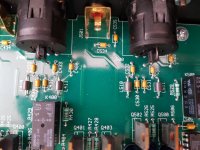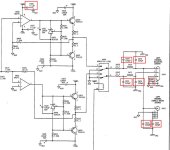Hello,
I work on an old DAC (Parasound DAC 2000) inside which there are a lot of small caps with a yellow color, as shown on the attached photo:

These are small value: 220pF as squared (squared in red color) in the attached schematic, or 0.1µF for the other bypass capacitors.

I would like to know what type of caps there are ? they are probably Film caps, but do you know what type of ?
Thank you very much,
I work on an old DAC (Parasound DAC 2000) inside which there are a lot of small caps with a yellow color, as shown on the attached photo:

These are small value: 220pF as squared (squared in red color) in the attached schematic, or 0.1µF for the other bypass capacitors.

I would like to know what type of caps there are ? they are probably Film caps, but do you know what type of ?
Thank you very much,
Standard ceramic. Something like:
https://www.mouser.com/ProductDetail/KEMET/C410C221FAG5TA?qs=QTajy0ParP6CBkeGVwoS0A==
Hal
https://www.mouser.com/ProductDetail/KEMET/C410C221FAG5TA?qs=QTajy0ParP6CBkeGVwoS0A==
Hal
OK guys,
Since they are in the signal path of the output stage, I plan to replace them by PolyPropylene (PP) caps, expecting an improvement in sound: agree ?
Thank you
Since they are in the signal path of the output stage, I plan to replace them by PolyPropylene (PP) caps, expecting an improvement in sound: agree ?
Thank you
I am OK with you regarding the low inductance benefit, but don't you think that PP usually sound better than ceramic in these locations (signal path) ?
They are NOT in signal path, but are for bypass / preventing oscillations, for which ceramic caps are cheap and best solutionOK guys,
Since they are in the signal path of the output stage, I plan to replace them by PolyPropylene (PP) caps, expecting an improvement in sound: agree ?
Thank you
An LC output filter is certainly in the signal path, but use care in substitutions.
Their parasitic inductance must be very low.
Their parasitic inductance must be very low.
That type of axial lead ceramic cap was popular in the 70s and early 80s. You also see axial lead caps with glass encapsulation rather than epoxy. If you change the caps, be careful, as the epoxy-encapsulated caps tend to shed their leads if you are too rough with them or linger too long with the soldering iron. The glass-encapsulated variety are a bit more forgiving.
The LC filter is in the signal path, but its impact will be above 1 MHz or possibly above 10 MHz, i.e., well above the audio band. So unless you believe you can hear 1-10 MHz I'd leave them alone. And if you do believe you can hear 1-10 MHz I'm curious how you navigate in the world of AM radio... 🙂
C0G/NP0 ceramic capacitors are the best option for those.
Tom
C0G/NP0 ceramic capacitors are the best option for those.
Tom
For the 220pF caps I second the recommendation for NPO/COG ceramic caps if you are going to change them.
Get your head out of the "I have to re-cap this thing" disease (because someone said so).OK guys,
Since they are in the signal path of the output stage, I plan to replace them by PolyPropylene (PP) caps, expecting an improvement in sound: agree ?
Thank you
Leave well enough alone.
Now these are a good film capacitor. If you are gonna do it, do it right.
https://www.mouser.com/ProductDetail/?qs=WI052HLiD5gveqDNdUZnKQ==
https://www.mouser.com/ProductDetail/?qs=WI052HLiD5gveqDNdUZnKQ==
Remember the mantra: if it ain't broke, don't fix it. The caps are MLCC encased in a TH package, but they are most likely group I ceramic, COG or similar, and there is nothing to be gained by replacing them, except unexpected problems and mishaps; concentrate on real issues instead
One other voice here to say leave it alone if it is working. I would also like to agree with the recommendation that, if you absolutely have to replace them, going with a C0G if it is in the signal chain as other ceramic dielectrics have significant nonlinearities versus the applied voltage.
Hal
Hal
- Home
- Design & Build
- Parts
- What kind of caps these are?